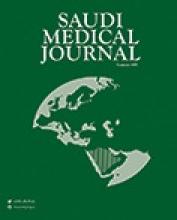Abstract
OBJECTIVE: To identify and classify Iranian isolates of diarrheagenic Escherichia coli E. coli on the basis of presence of virulence genes and to determine antibiotic susceptibility of isolated strains.
METHODS: The current cross-sectional study was conducted in 2005 at the Pasteur Institute, Tehran, Iran. One hundred and ninety-three diarrheagenic E. coli isolated from diarrheal patients in different regions of Iran were included in current study. Virulence factor genes for diarrheagenic E. coli were detected by polymerase chain reaction.
RESULTS: Of the 193 diarrheagenic E. coli detected by PCR, 86 44.5% were Shiga toxin-producing E. coli STEC, 74 38.4% enteropathogenic E. coli EPEC, 19 9.8% enteroaggregative E. coli, and 14 7.3% enterotoxigenic E. coli isolates. Susceptibility to 12 clinically important antimicrobial agents was determined for 193 strains of diarrheagenic E. coli. A high incidence of resistance to tetracycline 63%, ampicillin 62%, streptomycin 56%, amoxicillin/clavulanic acid 44.5%, trimethoprim/sulfamethoxazole 39.5%, and cephalothin 37% was observed.
CONCLUSION: The STEC and EPEC strains with high resistance to tetracycline and ampicillin, but highly susceptible to quinolones are among the most important causative agent of diarrhea in Iran. This study suggests that antimicrobial resistance is widespread among E. coli strains colonizing Iranian patients. Guidelines for appropriate use of antibiotics in developing countries require updating.
- Copyright: © Saudi Medical Journal
This is an open-access article distributed under the terms of the Creative Commons Attribution-Noncommercial-Share Alike 3.0 Unported, which permits unrestricted use, distribution, and reproduction in any medium, provided the original work is properly cited.






